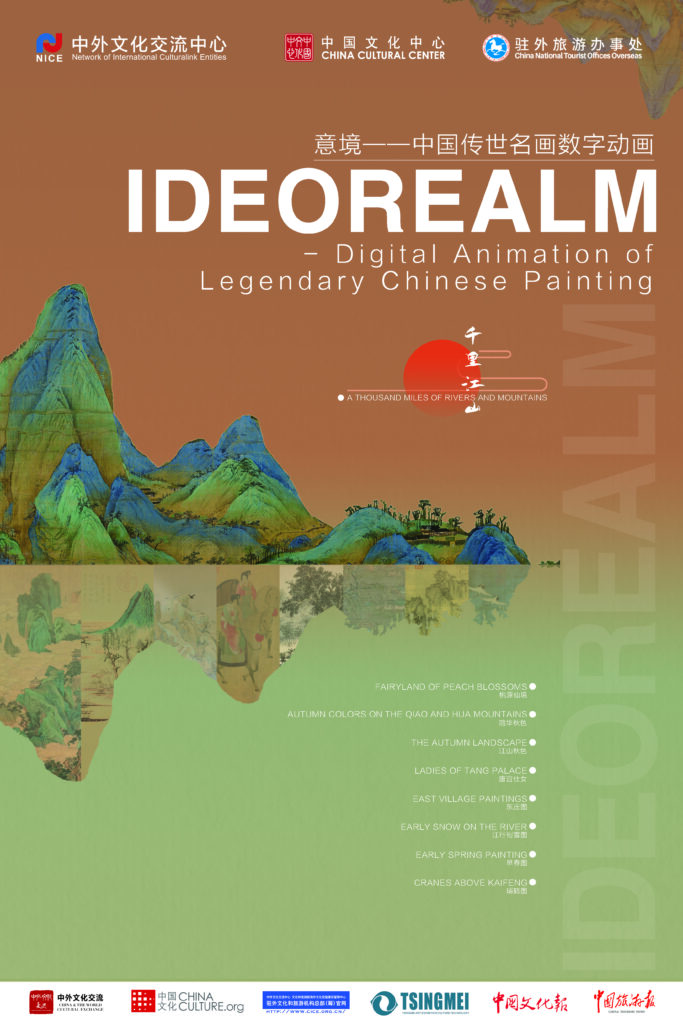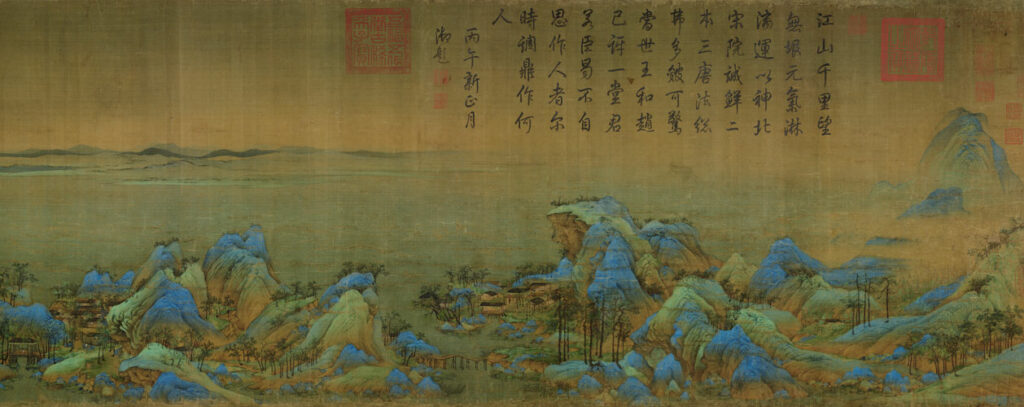
Elements have been selected from famous Chinese paintings into the “Ideorealm – Digital Animation of Legendary Chinese Paintings” series of short video projects, covering different types of landscape paintings, lady paintings, garden paintings, etc., spanning from the Five Dynasties to the Ming Dynasty (A.D 907 – A.D 1644). These short videos adopt the form of animation to deconstruct painting techniques, appreciate the stories of paintings, and express the philosophical thoughts of “the principle of nature” and “the harmony between human and nature”, presenting an “Oriental Garden” brimming with classical aesthetics to all audiences.
Online Exhibition:
https://i.eqxiu.com/s/o0D0DzWF?bt=yxy&share_level=1&from_user=2022011366bd8600&from_id=4a865060-2&share_time=1642058015236

Qian Li Jiang Shan Tu (A Thousand Miles of Rivers and Mountains)
Northern Song Dynasty (A.D 960 – A.D 1127), Wang Ximeng
Qian Li Jiang Shan Tu (A Thousand Miles of Rivers and Mountains) is a blue and green scroll masterpiece completed within half a year by Wang Ximeng, an eighteen-year-old painter in the Northern Song Dynasty. It is a representative work of outstanding artistic achievements in the blue and green landscape paintings of the Song Dynasty. The scroll is 51.5cm long and 1191.5cm wide and now exhibits in the Palace Museum in Beijing. The stunning landscape in Qian Li Jiang Shan Tu is colored with azurite and mineral green, thick mountains and rocks, lush and greenery picture, and rich colors. By using the method of scattered perspective, the painting presents the artistic effect that “the scene changes as the steps move”, vividly expressing the concept of harmonious coexistence between human and nature.
Tao Yuan Xian Jing Tu (Taoyuan Fairyland) Ming Dynasty (A.D 1368 – A.D 1644), Qiu Ying
Tao Yuan Xian Jing Tu (Taoyuan Fairyland) is a masterpiece created by Qiu Ying, one of the “Legendary Four Artists of the Ming Dynasty”. The scroll is 175cm long and 66.7cm wide currently in the collection of Tianjin Museum. Tao Yuan Xian Jing Tu adopts a vertical and lofty composition and is divided into three layers, presenting a secluded resort far away from the bustling city. Through the author’s ingenious depiction of natural landscapes and dynamic characters, the characters in the painting and the scenery complement each other and express smartly the joy of seclusion in the minds of literati at that time.
Que Hua Qiu Se Tu (Autumn Scenery of Mount Huabuzhu and Mount Que)
Yuan Dynasty (A.D 1271 – A.D 1368) Zhao Mengfu
Que Hua Qiu Se Tu (Autumn Scenery of Mount Huabuzhu and Mount Que) is created by Yuan Dynasty painter Zhao Mengfu. The scroll is 28.4cm long and 90.2cm wide, currently collected in Chinese Taipei Palace Museum. Que Hua Qiu Se Tu depicts the autumn scenery of Mount Huabuzhu and Mount Que in Jinan. It adopts a plain and distant composition to create a clear and calm ambience. The virtual and the real coexist, presenting a quiet and leisurely natural style. The colors of the two peaks in the picture are more eye-catching. Other sceneries like tiny islands and trees are painted with different shades of cyan. Houses, cows and some leaves are painted with warm, bright colors such as red and yellow. It shows the clearness and cleanliness of autumn, and also the peace and tranquility of humanity.
Jiang Shan Qiu Se Tu (The Autumn Landscape)
Southern Song Dynasty (A.D 1127 – A.D 1279), Zhao Boju
Jiang Shan Qiu Se Tu (The Autumn Landscape) was created by Zhao Boju, royal family member of the Song Dynasty. The scroll is 56.6cm long and 323.2cm wide. Currently in the collection of the Palace Museum in Beijing. Jiang Shan Qiu Se Tu depicts the scenery of mountains and rivers in the north. The layout of the picture is rigorous, the outline is lean, the color is gorgeous, mainly in azurite and mineral green with other bright and harmonious colors like vermilion, ocher, white, etc. In the layout, the traditional “scattered perspective” method is used to combine lofty and far-reaching styles, which brings the effect of large capacity, odd layout and balanced composition, as well as a harmonious relationship among the variability. The entire artwork is fulfilled with “morale” of the literati, expressing the author’s deep feeling of the loss of his homeland.
Tang Gong Shi Nv Tu (Ladies of Tang Palace)
Tang Dynasty (A.D 618 – A.D 907), Zhang Xuan & Zhou Fang
Tang Gong Shi Nv Tu (Ladies of Tang Palace) is composed of five Tang Dynasty figure paintings, which are Zhang Xuan’s Guo Guo Fu Ren You Chu Tu (Lady Guoguo’s Spring Outing, collected in Liaoning Museum) and Dao Lian Tu (Court Ladies Preparing Newly Woven Silk, collected in the Museum of Fine Arts, Boston), Zhou Fang’s Zan Hua Shi Nv Tu (Ladies Wearing Flowers Hairpins, collected in Liaoning Museum), Hui Shan Shi Nv Tu (Lady With A Fan, collected in the Palace Museum in Beijing) and Gong Yue Tu (Musical Performances in the Palace, collected in Chinese Taipei Palace Museum) in the late Tang Dynasty.
Tang Gong Shi Nv Tu mainly describes the living conditions of aristocratic women in the Tang Dynasty. Lines are meticulously crafted, and the colors are rich and mostly in red. The appearance of people and objects are plump, the movements are concentrated and natural. Amazing Tang scenery has been vividly portrayed.
Dong Zhuang Tu (East Village)
Ming Dynasty (A.D 1368 – A.D 1644), Shen Zhou
Dong Zhuang Tu (East Village) is an album of Chinese paintings created by Shen Zhou, the founder of the Wumen School of Painting and one of the “Legendary Four Artists of the Ming Dynasty”. 21 out of the 24 pictures are in existence, now in the collection of Nanjing Museum. Dong Zhuang Tu was painted by Shen Zhou for his friend Wu Kuan’s private garden, Dong Zhuang (East Village). This artwork is in folio format. Water has been used as an important element, where the fine strokes are exquisite and the thick strokes are expressive. The geographical location and the garden features implicitly and powerfully express the quiet, elegant and handsome garden charm. In the use of color, Shen Zhou has successfully created and achieved excellent color performance by blending clear water color with heavy ink color and light crimson color.
Jiang Xing Chu Xue Tu (Early Snow River View)
The Five Dynasties (A.D 907 – A.D 960), Zhao Gan
Jiang Xing Chu Xue Tu (Early Snow River View) is an ink and color painting on silk created by Zhao Gan during the period of the Five Dynasties. The artwork is 25.9cm by 376.5cm. Currently collected in Chinese Taipei Palace Museum. Jiang Xing Chu Xue Tu describes the working scenes of people in fishing villages along the Yangtze River after the first snow. Forms of close-range and medium-range shots have been implemented, just like the current close-up photography technique. The use of this technique enlarges the characters in landscape paintings, condensing a large number of characters in a close scene, presenting in front of us, and makes these characters as regular key elements in the landscape paintings. This scroll reflects the pursuit of self-individuality in the art of Southern Tang painting and the civilian art style of real life. It has become the most contemporary feature of Southern Tang painting.
Zao Chun Tu (Early Spring)
The Northern Song Dynasty (A.D 960 – A.D 1279), Guo Xi
Zao Chun Tu (Early Spring) is created by Guo Xi, a royal painter from the Northern Song Dynasty. The painting is 158.3cm by 108.1cm. Currently collected in Chinese Taipei Palace Museum. Zao Chun Tu depicts the scene in the mountains in the north during early spring. It adopts a panoramic composition and integrates high, far-reaching, and flat techniques in one painting. The whole picture presents a strong vertical feeling. Through the meticulous depiction of the mountains, the author successfully expressed the seasonal changes of winter and spring, the earth’s revival, and the rejuvenation of all things. The picture is quiet and vibrant, full of vigor and delight, thus creating a feasible, impressive, travelable, and habitable rhyme.
Rui He Tu (Cranes above Kaifeng)
Northern Song Dynasty (A.D 960 – A.D 1127), Zhao Ji
Rui He Tu (Cranes above Kaifeng) is created by Zhao Ji, Emperor Huizong of Song. The painting is 51cm by 138.2cm. Currently collected in Liaoning Museum. Rui He Tu depicts the spectacular scene of cranes hovering above the palace. The composition has changed from the traditional. Eaves reflect the flying cranes above, giving the storyline to audiences, where the surreal expression technique has been implemented. Each flying crane has its own postures. The picture is full of vitality, solemn and luxurious feelings, expressing Song Huizong’s expectation of prosperity and peace in his empire.
Facebook: China Cultural Center in Stockholm
https://www.facebook.com/China-Cultural-Center-in-Stockholm-110983273921638
Instagram: chinaculturalcenterinstockholm
https://www.instagram.com/chinaculturalcenterinstockholm/
Youtube: China Cultural Center in Stockholm
https://www.youtube.com/channel/UCYqOYwuQtyTHC-iMNdfExsw
Tik Tok: cccinstockholm
@cccinstockholm
地址/Address:
Västra Trädgårdsgatan 2, Stockholm


